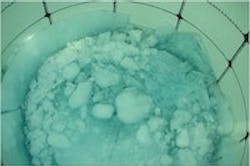Active Mixing Keeps Tanks Ice Free
While most people enjoy a little ice in their water glass, a large ice plug inside a water storage tank can spell disaster. Unfortunately, ice damage is difficult to avoid in northern climates. Depending on the air temperature, inlet water temperature, amount of turnover, and presence of tank insulation and heaters, ice formation can range from a thin skin to a several-ton ice cap.
Like an iceberg, a massive chunk of ice can scrape tank coatings as the water level fluctuates. If ladders and other tank internals become locked in ice, the rise and fall of the ice cap can literally tear these assets apart. Additionally, complete freezing of the upper parts of a tank can stretch the walls, leading to coating failure and even tank rupture. Numerous tanks in Canada and the northern U.S. have been badly damaged and ruptured by ice formation. Even modest damage to tank coatings may require a partial or complete overhaul, costing hundreds of thousands of dollars.
Traditional Solutions Fall Flat
Engineers and operators have resorted to a host of conventional options for ice prevention in water storage tanks. Insulating a tank increases its thermal resistance and lowers heat loss from the water, but this is costly to apply. Some engineers avoid specifying certain types of tank construction, such as bolted steel, for fear that they are more susceptible to ice damage, leaving municipalities with few and often more expensive options.
Heaters are another common solution used inside tanks to reduce ice formation. Frequently, these systems must substantially overheat the water in order to be effective. As a result, even very small water tanks can end up using tens of kilowatts.
Active submersible mixers are a new way of managing ice formation inside water storage tanks. Using a patented, high-efficiency impeller, a submersible active mixer pushes water from the bottom of the tank to the top, circulating the tank’s entire contents to ensure temperature stability and improve overall water quality.
Active Mixers in British Columbia
The operators and engineers of the Pouce Coupe Reservoir, operated by the city of Dawson Creek, B.C., considered the challenges of managing ice formation as they designed a new 0.75-million-gal water storage tank. While the population served by Pouce Coupe is small, the tank required excess capacity for fire prevention. If Pouce Coupe used four heaters to keep the water from freezing, with exterior temperatures as low as -20° C to -40° C, their energy consumption would reach 30 kilowatts (kW).
Instead, Pouce Coupe integrated a submersible active mixer, cutting power requirements to only 7 kW. During the new tank’s first winter in operation, operators observed no ice formation in the top of the tank. Operators also found an added benefit: The mixer kept chlorine residual levels more stable in the distribution system. As a result, the operators in the nearby city of Dawson Creek are retrofitting an active mixer into one of their existing tanks.
Arriving in Anchorage
Like Pouce Coupe, operators of the water system in Anchorage, Alaska, struggled with ice formation in their 1-million-gal steel Girdwood tank for years. Operators dealt with repeated damage to the tank’s interior coatings and center column. The tank had the added complication of being fed by two wells, one of which was high in sulphur, which prompted frequent taste and odor complaints. Operators installed the submersible active mixer in September 2010 and continuously monitored interior conditions throughout the winter.
Despite outside temperatures of -15° F to -20° F, the tank remained ice-free. During this past summer, the operators at Girdwood enjoyed an added benefit from the active mixer. After filling the tank with water from the high-sulphur well, the mixer aerated the water and lowered sulphur levels. Operators received no taste and odor complaints from customers.
With the benefits of active mixing becoming better known, more municipalities are adding mixers to all their tanks. Utility Service Co., a contract tank maintenance firm in the U.S., has recommended the installation of submersible active mixers in all the tanks they manage in northern climates. “Active mixers protect infrastructure and improve water quality; it’s a no-brainer,” Utility Service Specialty Products Vice President Randy Moore said.
To learn more about how mixing can help prevent ice damage inside your tanks, please register here for a free webinar on Wednesday, Jan. 25, at 7 a.m. PST.
Peter S. Fiske is the chief executive officer of PAX Water Technologies. Fiske can be reached at [email protected] or 866.729.6493.
